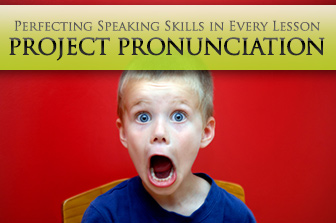
Pronunciation practice should be a natural part of every ESL lesson.
Speaking correctly is such a huge part of learning English, varied and interesting pronunciation practice should include communication, correction, and lots of organic speaking opportunities.

Project Pronunciation: Perfecting Speaking Skills in Every Lesson
-
1
Correct, Correct, Correct
One of the most important aspects of any ESL classroom is creating a safe environment for learning where students are also corrected when they misspeak or make mistakes. This is especially important when approaching pronunciation because if students are allowed to make mistakes over and over again, they will develop bad habits that are difficult to break. In order to make corrections meaningful, students should repeat the correction on the spot immediately after the teacher corrects them. Students look to the teacher for consistent pronunciation correction because it establishes a level of trust; you are not going to allow them to speak incorrectly. So it is key for teachers to be able to correct with confidence and without stopping the flow of games or conversations. A good guideline for correcting pronunciation is to wait until you hear a student misspeak at least twice before jumping in to adjust the mistake. You have to seize the right moment to correct. Don't miss the opportunity to pass, but if you do miss your moment, be sure to snag the next chance. In addition, if you hear multiple students making the same mistake, it is time to not only correct, but to stop what you are doing to provide a short explanation of the correction.
-
2
Read it Aloud
It can sometimes be challenging to create stimulating reading activities that provide an equal amount of practice for all students. In order to practice pronunciation as well as vocabulary, stress and intonation students should spend some amount of class time reading aloud. This doesn't have to be as dry as it sounds. Make games out of it. One option is to divide the class in half, and have a short reading or conversation in front of all students. Each half of the class will take turns reading a sentence as a group. The groups will alternate quickly. To make it more fun have students stand as a group as they read their sentence uniformly. This game should move fast from group to group, and students should be encouraged to speak clearly, loudly, and enthusiastically. You can also throw in additional elements like asking students to read with a particular emotion or characteristic like sadly or egotistically!
Other ways to incorporate reading aloud is to build in rounds practice. Rounds practice is simply when students go around the room and individually practicing Q and A, specific grammar structures, or conversation topics. Students are generally given a structure to follow, but must create their own question, answer, or opinion. This encourages students to pay attention and to be present in class because they know that they will be expected to speak in each and every class. Incorporating rounds practice takes the pressure off speaking aloud because the expectation is the same for everyone, and it yields a range of different examples. It also gets students interacting with one another. The teacher will help if students get stuck, and students will also begin helping one another when they run into problems with grammar, pronunciation or understanding.
-
3
Dictionary Games
There are several ways to make using a dictionary fun and inspiring. Some of the best ways to do this are to create games that utilize a dictionary so that students not only practice pronunciation of new words, they also begin learning how to build vocabulary and remember new words.
To introduce dictionary work, make a team game out of quickly looking up words. You can do this by putting students into small groups and providing each group with an English dictionary. Then choose a word at random, say it to the students, and have them race to find it in their dictionaries. The first group to find the word reads out the definition and practices natural pronunciation as they go. To reward the winning group allow them to choose the next word to search. Before playing this game be sure that you have introduced how to locate words in a dictionary, and how to utilize the elements of the entries such as the pronunciation guide, the parts of speech, and the definitions. A variation on this game could be to write out a list of words on the board that the students must look up. That way they have to work out the pronunciation as well as locate the definition. To make this even more challenging, misspell some of the words, and have students make the corrections together.
One last idea to utilize dictionary work is to create an English Dictionary Word of the Day Wall. This works great for all levels, and you can have students contribute to it by writing down new words on color coded cards by part of speech. They can then write out the pronunciation and the meaning of the word before it gets posted on the wall. These dictionary tasks and games get students comfortable using dictionaries and empowers them to take control of their learning and pronunciation.
Each and every ESL class should incorporate pronunciation practice with a variety of speaking exercises.
Students will increase their retention of grammar and vocabulary when they gain confidence about pronunciation.
P.S. If you enjoyed this article, please help spread it by clicking one of those sharing buttons below. And if you are interested in more, you should follow our Facebook page where we share more about creative, non-boring ways to teach English.







